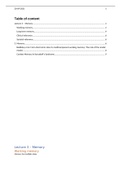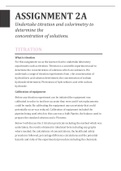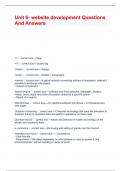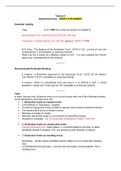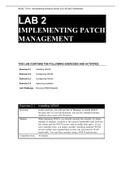The goods market in an open economy
Key questions:
• What is difference between the nominal and real exchange rate?
• How does opening up the economy to international trade affect the IS relation?
• What is the impact of changes in demand (both domestic and foreign) on output and the trade balance?
• What is the Marshall-Lerner condition?
• How do fiscal and monetary policies (called exchange rate policies in this chapter) affect the components of
aggregate demand in an open economy?
1. The IS relation in an open economy
• Closed economy consumers face two choice: save or consume
• When goods markets are open, domestic consumers face a second decision: whether to buy domestic goods
or foreign goods.
• Central to this second decision (to buy domestic goods or foreign goods) is the price of domestic goods
relative to foreign goods: the real exchange rate.
Nominal exchange rate
• Nominal exchange rates between two currencies can be quoted in one of two ways:
1. As the price of the domestic currency in terms of the foreign currency. If, for example, we look at the United
States and the United Kingdom, and think of the dollar as the domestic currency and the pound as the
foreign currency, we can express the nominal exchange rate as the price of a dollar in terms of pounds. In
October 2015, the exchange rate defined this way was 0.65. In other words, one dollar was worth 0.65
pounds
2. As the price of the foreign currency in terms of the domestic currency. Continuing with the same example,
we can express the nominal exchange rate as the price of a pound in terms of dollars. In October 2015, the
exchange rate defined this way was 1.55. In other words, one pound was worth 1.55 dollars.
• Either definition is fine; the important thing is to remain consistent.
• In this course, we define the nominal exchange rate as the price of the domestic currency in terms of foreign
currency, and denote it by E.
Exchange rates between the dollar and most foreign currencies are determined in foreign exchange markets and
change every day—indeed every minute of the day.
These changes are called nominal appreciations or nominal depreciations.
• An appreciation of the domestic currency is an increase in the price of the domestic currency in terms of a
foreign currency. Given our definition of the nominal exchange rate, E, an appreciation corresponds to an
increase in the exchange rate.
• A depreciation of the domestic currency is a decrease in the price of the domestic currency in terms of a
foreign currency. So given our definition of the exchange rate, a depreciation of the domestic currency
corresponds to a decrease in the exchange rate, E.
, The IS relation in the open economy
• Need to distinguish between domestic demand for goods (C+I+G) and demand for domestic goods (which
has to take into account imports and exports)
They sound similar but they are different
- Part of the domestic demand for goods falls on foreign goods
- Some of the demand for domestic goods comes from foreigners
Demand for domestic goods in the open economy
Demand for domestic goods: Z= C+ I + G –IM/ε +X
• To get from the domestic demand for goods (C+ I + G) to the demand for domestic goods (C+ I + G –IM/ε
+X) we must:
1. Subtract imports (IM/ε), which is that part of domestic demand that falls on foreign goods rather than
domestic goods.
• NOTE: IM/ε NOT JUST IM. Why?
- Foreign goods are different to domestic goods, so we cannot just subtract the IM. If we were to do so, we
would be subtracting apples (foreign goods) from oranges (domestic goods).
- We need to express the value of imports in terms of domestic goods. This is what IM/ε stands for in the
equation.
- Recall ε is the real exchange rate (which tells us the price of domestic goods in terms of foreign goods)
- 1/ε is therefore the price of foreign goods in terms of domestic goods
- Therefore, IM x (1/ ε) or simply IM/ε is the value of imports in terms of domestic goods (aka foreign demand
for domestic goods)
2. Second, we must add exports (X), which is that part of domestic demand that comes from abroad.
Key questions:
• What is difference between the nominal and real exchange rate?
• How does opening up the economy to international trade affect the IS relation?
• What is the impact of changes in demand (both domestic and foreign) on output and the trade balance?
• What is the Marshall-Lerner condition?
• How do fiscal and monetary policies (called exchange rate policies in this chapter) affect the components of
aggregate demand in an open economy?
1. The IS relation in an open economy
• Closed economy consumers face two choice: save or consume
• When goods markets are open, domestic consumers face a second decision: whether to buy domestic goods
or foreign goods.
• Central to this second decision (to buy domestic goods or foreign goods) is the price of domestic goods
relative to foreign goods: the real exchange rate.
Nominal exchange rate
• Nominal exchange rates between two currencies can be quoted in one of two ways:
1. As the price of the domestic currency in terms of the foreign currency. If, for example, we look at the United
States and the United Kingdom, and think of the dollar as the domestic currency and the pound as the
foreign currency, we can express the nominal exchange rate as the price of a dollar in terms of pounds. In
October 2015, the exchange rate defined this way was 0.65. In other words, one dollar was worth 0.65
pounds
2. As the price of the foreign currency in terms of the domestic currency. Continuing with the same example,
we can express the nominal exchange rate as the price of a pound in terms of dollars. In October 2015, the
exchange rate defined this way was 1.55. In other words, one pound was worth 1.55 dollars.
• Either definition is fine; the important thing is to remain consistent.
• In this course, we define the nominal exchange rate as the price of the domestic currency in terms of foreign
currency, and denote it by E.
Exchange rates between the dollar and most foreign currencies are determined in foreign exchange markets and
change every day—indeed every minute of the day.
These changes are called nominal appreciations or nominal depreciations.
• An appreciation of the domestic currency is an increase in the price of the domestic currency in terms of a
foreign currency. Given our definition of the nominal exchange rate, E, an appreciation corresponds to an
increase in the exchange rate.
• A depreciation of the domestic currency is a decrease in the price of the domestic currency in terms of a
foreign currency. So given our definition of the exchange rate, a depreciation of the domestic currency
corresponds to a decrease in the exchange rate, E.
, The IS relation in the open economy
• Need to distinguish between domestic demand for goods (C+I+G) and demand for domestic goods (which
has to take into account imports and exports)
They sound similar but they are different
- Part of the domestic demand for goods falls on foreign goods
- Some of the demand for domestic goods comes from foreigners
Demand for domestic goods in the open economy
Demand for domestic goods: Z= C+ I + G –IM/ε +X
• To get from the domestic demand for goods (C+ I + G) to the demand for domestic goods (C+ I + G –IM/ε
+X) we must:
1. Subtract imports (IM/ε), which is that part of domestic demand that falls on foreign goods rather than
domestic goods.
• NOTE: IM/ε NOT JUST IM. Why?
- Foreign goods are different to domestic goods, so we cannot just subtract the IM. If we were to do so, we
would be subtracting apples (foreign goods) from oranges (domestic goods).
- We need to express the value of imports in terms of domestic goods. This is what IM/ε stands for in the
equation.
- Recall ε is the real exchange rate (which tells us the price of domestic goods in terms of foreign goods)
- 1/ε is therefore the price of foreign goods in terms of domestic goods
- Therefore, IM x (1/ ε) or simply IM/ε is the value of imports in terms of domestic goods (aka foreign demand
for domestic goods)
2. Second, we must add exports (X), which is that part of domestic demand that comes from abroad.


